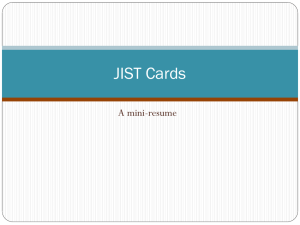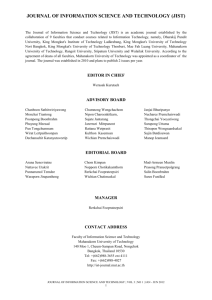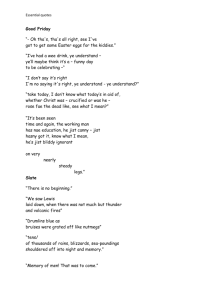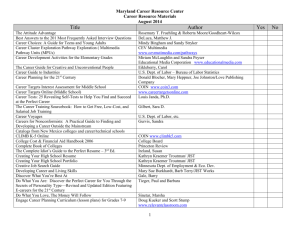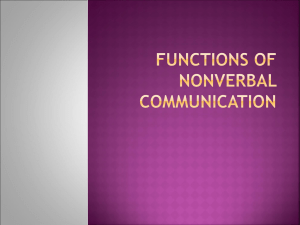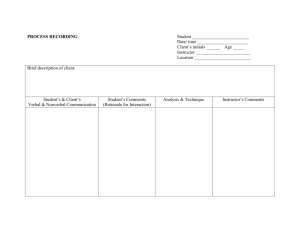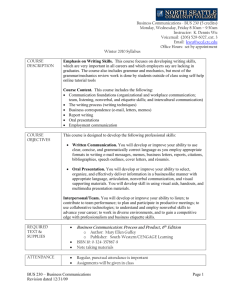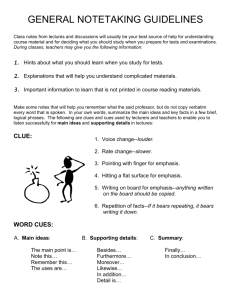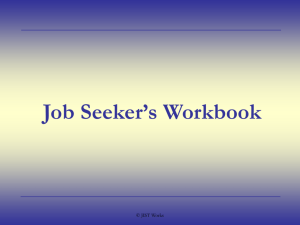Workplace Communication Skills DVD Instructor's
advertisement
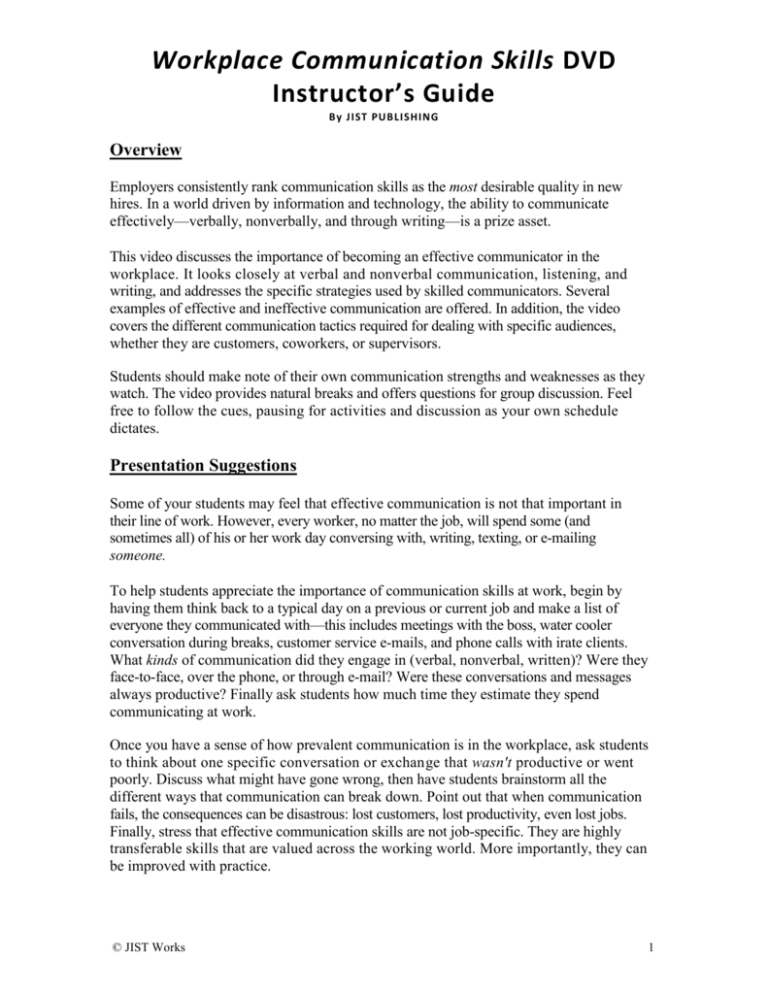
Workplace Communication Skills DVD Instructor’s Guide By JIST PUBLISHING Overview Employers consistently rank communication skills as the most desirable quality in new hires. In a world driven by information and technology, the ability to communicate effectively—verbally, nonverbally, and through writing—is a prize asset. This video discusses the importance of becoming an effective communicator in the workplace. It looks closely at verbal and nonverbal communication, listening, and writing, and addresses the specific strategies used by skilled communicators. Several examples of effective and ineffective communication are offered. In addition, the video covers the different communication tactics required for dealing with specific audiences, whether they are customers, coworkers, or supervisors. Students should make note of their own communication strengths and weaknesses as they watch. The video provides natural breaks and offers questions for group discussion. Feel free to follow the cues, pausing for activities and discussion as your own schedule dictates. Presentation Suggestions Some of your students may feel that effective communication is not that important in their line of work. However, every worker, no matter the job, will spend some (and sometimes all) of his or her work day conversing with, writing, texting, or e-mailing someone. To help students appreciate the importance of communication skills at work, begin by having them think back to a typical day on a previous or current job and make a list of everyone they communicated with—this includes meetings with the boss, water cooler conversation during breaks, customer service e-mails, and phone calls with irate clients. What kinds of communication did they engage in (verbal, nonverbal, written)? Were they face-to-face, over the phone, or through e-mail? Were these conversations and messages always productive? Finally ask students how much time they estimate they spend communicating at work. Once you have a sense of how prevalent communication is in the workplace, ask students to think about one specific conversation or exchange that wasn't productive or went poorly. Discuss what might have gone wrong, then have students brainstorm all the different ways that communication can break down. Point out that when communication fails, the consequences can be disastrous: lost customers, lost productivity, even lost jobs. Finally, stress that effective communication skills are not job-specific. They are highly transferable skills that are valued across the working world. More importantly, they can be improved with practice. © JIST Works 1 Workplace Communication Skills Instructor's Guide When you feel students have begun thinking about these issues, give them the Anticipation Quiz to complete prior to watching the video. If you wish, allow the students to state their answers and discuss them. Show the video. Encourage students to take notes or to make changes to the answers they put down for the Anticipation Quiz while watching the video. At the conclusion of the video, ask students to discuss any changes they made to their answers on the Anticipation Quiz as a result of information they learned. Follow up this discussion with the Activities. Use the Discussion Questions to request oral or written responses from students or assign the questions as homework essays. Give the Quick Quiz at the conclusion of class and correct the quizzes as a group. Assign the Homework Option, if desired. Anticipation Quiz Directions: Answer these questions as completely as possible. You may revise your answers as you watch the video. 1. Define communication. 2. Give three tips for effective verbal communication. 3. What is the difference between active and passive listening? 4. What are the four keys to writing effectively at work? Answer Key 1. The means by which we send and receive messages. 2. Answers may include speaking clearly and at an even pace, using a positive tone, giving others a chance to speak, choosing words carefully, curbing distracting speech habits, avoiding sensitive topics, knowing your audience, and using proper grammar. 3. Active listening requires direct feedback from the listener, often in the form of questions and clarification. 4. Make your message clear, direct, appropriate, and professional. © JIST Works 2 Workplace Communication Skills Instructor's Guide Activities Activity #1 Title: Nonverbal Communication Charades Format: Group Time: 15-20 minutes Materials: Slips of paper with responses in a cup or hat Procedure: 1. This exercise is designed to show how powerful our nonverbal cues can be in conveying our tone and mood. Write the following emotional responses (or some of your own) down on slips of paper. To make it easier, you can also write them on the board. BORED DEPRESSED THOUGHTFUL HAPPY ENGAGED DISGUSTED IMPATIENT TIRED 2. Choose three students to join you in a role-play scenario where you are the supervisor at a meeting. Each student picks one of the responses and must convey their reaction using only nonverbal cues (facial expressions, body language, posture, hand gestures, etc.) as you say the following: “Customer response to our new product line has been, for the most part, positive. Some customers have complained about the smaller size of the line, but most think it is an improvement. We have seen sales increase 12 percent in the first quarter and are prepared to roll out our new advertising campaign next week. Does anybody have any questions?” 3. When you have finished, give the other students in the class a chance to guess which emotion each “employee” was conveying. Take time to discuss how even subtle gestures and facial expressions can be noticeable and what strategies students can use for monitoring their own expressions and interpreting the nonverbal cues of others. 4. Alternatively (or additionally), you can make this an exercise in effective verbal communication--specifically creating the proper tone for your audience. As before, give three students slips of paper with emotional responses, but this time they take turns acting as the supervisor and you are the employee. Each student should deliver one of the following lines to you in the tone and manner indicated by their chosen mood. When students have finished, be sure to discuss the importance of professionalism, courtesy, respect, and audience awareness in verbal communication. “I have to say, these numbers weren’t what I was expecting.” “Do you think you might have that done by this afternoon?” “What do you want me to do with this?” © JIST Works 3 Workplace Communication Skills Instructor's Guide Activity #2 Title: E-mail Editor Format: Pairs/Group Time: 20-30 minutes Materials: Examples of poorly written e-mails, pen Procedure: 1. In writing, a bad example can be just as informative as a good one. Using the example provided at the end of this instructor’s guide (or examples you provide yourself), have students break into pairs and critique a bad e-mail message. Review the keys to effective written communication generally and e-mails specifically and highlight those strategies you want students to focus on most. Give students the opportunity to rewrite the e-mail to make it more effective. 2. When students have finished editing and rewriting, come back together as a class to discuss. Be sure to stress that they are their own editors at work, and that they should review everything they write before hitting “send.” 3. Alternatively, you can have students compose a “bad” e-mail message themselves before or during class and then trade with other students for the critique. If so, be sure to give them a subject to write about, such as a customer complaint or a new office policy. Discussion Questions 1. What impact does audience have on communication? How would a conversation with a supervisor differ from one with a customer? Make a list of all of the different kinds of audiences you communicate with at work, and then suggest one strategy that is specific to communicating with that audience. 2. When is it more appropriate to use the phone instead of texting or e-mailing? When is it better to have a face-to-face conversation? How does the subject of your communication impact the way you communicate? 3. How has relatively recent technology (e-mail, texting, blogging, social media) changed the way we communicate? Has it made us more or less effective communicators? Why? What can you do to make sure you are using communication technology effectively at work? 4. What is the difference between a good listener and a bad one? What can you do to be a better listener, at work or otherwise? Quick Quiz Note: You may read these questions out loud, allowing time for students to respond, or copy and hand this out as a written exercise. Directions: Indicate whether each statement is true or false, according to the video. © JIST Works 4 Workplace Communication Skills Instructor's Guide 1. A person’s culture, background, and upbringing influence how he or she communicates. 2. In all cases, an e-mail to a customer or coworker is more effective than a phone call. 3. When engaged in passive listening, it’s a good idea to interrupt with questions. 4. Ninety percent of our workplace communications are done in person or over the phone. 5. Nonverbal cues include hand gestures, facial expressions, and body posture. 6. When offering feedback, it is better to start statements with “you” rather than “I.” 7. When talking to customers, it’s better to make suggestions rather than promises. 8. When communicating online at work, you should always assume you are being monitored. 9. Threatening gestures or other offensive nonverbal cues could be considered a form of harassment. 10. When texting or writing e-mails, you should be sure to use ALL CAPS when you want to emphasize a point. Answer Key 6. 7. False True 3. False 8. True 4. False 9. True 1. True 2. False 5. True 10. False Homework Option Have each student keep a communication log for a day. Have students write down the names of 4-5 people they talk to, text with, or e-mail at work, school, or another setting. For each person, students should record the following: the general subject discussed, the tone of the exchange, the outcome (were the messages understood on both sides), and any effective communication strategies used. Have students share their logs the next day in class. © JIST Works 5 Workplace Communication Skills Instructor's Guide E-mail Example This is an e-mail sent to a customer by a sales representative. Can you find anything wrong with it? To: jtsmith@xmail.com From: hotlips123@yahoo.com Subject: OPEN THIS! To whom it may concern... Are you looking to replace all your old broken windows? Do you know how much money you are losing on you're heating bill EACH AND EVERY MONTH????!!! Let me give you a free in home estimate and show you how you can save loads of cash. : -) I have over seven years of experience in home window instillation; and my work is 100% gaurenteed. Feel free to call or e-mail. I look forward to hearing from you. TTFN, Max Erer Max's Windows and Repair In the space below, try rewriting the e-mail to make it more effective and professional. JIST, America’s Career Publisher For information on JIST’s many other helpful career and job search products, please visit www.jist.com or call 800-648-5478. © JIST Works 6
